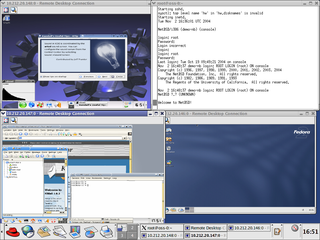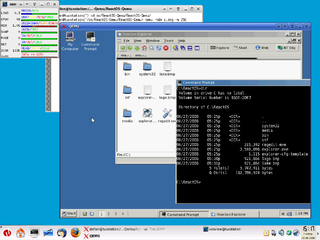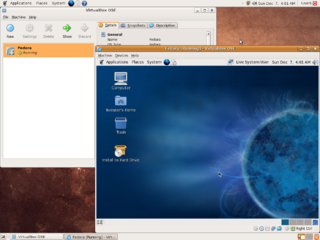Description
The computer and operating system instance that executes the twoOStwo process is referred to as the host machine. Instances of operating systems running inside a virtual machine are referred to as guest virtual machines. Like an emulator, twoOStwo provides a completely virtualized set of hardware to the guest operating system; for example, irrespective of make and model of the physical network adapter, the guest machine will see a Novell/Eagle NE2000 or Realtek RTL8029(AS) network adapter. twoOStwo virtualizes all devices within the virtual environment, including the video adapter, network adapter, and hard disk adapters. It also provides pass-through drivers for serial and parallel devices.
Because all guest virtual machines use the same hardware drivers irrespective of the actual hardware on the host computer, virtual machine instances are highly portable between computers. For example, a running virtual machine can be stopped, copied to another physical computer, and started.
Implementation
Conventional emulators like Bochs emulate the microprocessor, executing each guest CPU instruction by calling a software subroutine on the host machine that simulates the function of that CPU instruction. This level of abstraction allows the guest machine to run on host machines with a different type of microprocessor, but is also very slow.
A more efficient approach consists in software debugger technique. Some parts of the code are executed natively on the real processor; on 'bad' instructions, there are software interrupts that break execution of the guest operating system code and that particular instruction is emulated.
twoOStwo, as well as VMware Workstation, Virtual PC for Windows and QEMU with the kqemu add-on, take an even more optimized approach and run code directly when this is possible. This is the case for user mode and virtual 8086 mode code on x86.
The drawback is that the guest OS has to be compatible with the host CPU. So unlike an emulator, one cannot use twoOStwo to run classic Mac OS/PowerPC software on an Intel x86 processor. Another drawback is that it is not normally possible to efficiently nest virtual machines. Finally, although twoOStwo virtual machines run in user mode, twoOStwo itself requires installing various device drivers in the host operating system.
In computing, a virtual machine (VM) is an emulation of a computer system. Virtual machines are based on computer architectures and provide functionality of a physical computer. Their implementations may involve specialized hardware, software, or a combination.

Windows Virtual PC is a virtualization program for Microsoft Windows. In July 2006 Microsoft released the Windows version as a free product. In August 2006, Microsoft announced the Macintosh version would not be ported to Intel-based Macintosh computers, effectively discontinuing the product as PowerPC-based Macintosh computers would no longer be manufactured. The newest release, Windows Virtual PC, does not run on versions of Windows earlier than Windows 7, and does not officially support MS-DOS or operating systems earlier than Windows XP Professional SP3 as guests. The older versions, which support a wider range of host and guest operating systems, remain available. Starting with Windows 8, Hyper-V supersedes Windows Virtual PC.

VMware, Inc. is an American publicly traded software company from California. It provides cloud computing and virtualization software and services. It was one of the first commercially successful companies to virtualize the x86 architecture.

Xen is a type-1 virtual machine, providing services that allow multiple computer operating systems to execute on the same computer hardware concurrently. It was originally developed by the University of Cambridge Computer Laboratory and is now being developed by the Linux Foundation with support from Intel.
In the 80386 microprocessor and later, virtual 8086 mode allows the execution of real mode applications that are incapable of running directly in protected mode while the processor is running a protected mode operating system. It is a hardware virtualization technique that allowed multiple 8086 processors to be emulated by the 386 chip; it emerged from the painful experiences with the 80286 protected mode, which by itself was not suitable to run concurrent real mode applications well.
x86 virtualization is the use of hardware-assisted virtualization capabilities on an x86/x86-64 CPU.
A hypervisor is computer software, firmware or hardware that creates and runs virtual machines. A computer on which a hypervisor runs one or more virtual machines is called a host machine, and each virtual machine is called a guest machine. The hypervisor presents the guest operating systems with a virtual operating platform and manages the execution of the guest operating systems. Multiple instances of a variety of operating systems may share the virtualized hardware resources: for example, Linux, Windows, and macOS instances can all run on a single physical x86 machine. This contrasts with operating-system-level virtualization, where all instances must share a single kernel, though the guest operating systems can differ in user space, such as different Linux distributions with the same kernel.
In computing, para-virtualization is a virtualization technique that presents a software interface to the virtual machines which is similar, yet not identical to the underlying hardware–software interface.

QEMU is a free and open-source emulator and virtualizer that can perform hardware virtualization.
Platform virtualization software, specifically emulators and hypervisors, are software packages that emulate the whole physical computer machine, often providing multiple virtual machines on one physical platform. The table below compares basic information about platform virtualization hypervisors.
Parallels Workstation is the first commercial software product released by Parallels, Inc., a developer of desktop and server virtualization software. The Workstation software consists of a virtual machine suite for Intel x86-compatible computers which allows the simultaneous creation and execution of multiple x86 virtual computers. The product is distributed as a download package. Parallels Workstation has been discontinued for Windows and Linux as of 2013.

In computer science, hierarchical protection domains, often called protection rings, are mechanisms to protect data and functionality from faults and malicious behavior. This approach is diametrically opposite to that of capability-based security.
In computing, hardware-assisted virtualization is a platform virtualization approach that enables efficient full virtualization using help from hardware capabilities, primarily from the host processors. A full virtualization is used to emulate a complete hardware environment, or virtual machine, in which an unmodified guest operating system effectively executes in complete isolation. Hardware-assisted virtualization was added to x86 processors in 2005 and 2006 (respectively).
The following is a timeline of virtualization development. In computing, virtualization is the use of a computer to simulate another computer. Through virtualization, a host simulates a guest by exposing virtual hardware devices, which may be done through software or by allowing access to a physical device connected to the machine.

VMware ESXi is an enterprise-class, type-1 hypervisor developed by VMware for deploying and serving virtual computers. As a type-1 hypervisor, ESXi is not a software application that is installed on an operating system (OS); instead, it includes and integrates vital OS components, such as a kernel.

In computer science, virtualization is a modern technique developed in late 1990s and is different from simulation and emulation. Virtualization employs techniques used to create instances of an environment, as opposed to simulation, which models the environment; or emulation, which replicates the target environment such as certain kinds of virtual machine environments. Full virtualization requires that every salient feature of the hardware be reflected into one of several virtual machines – including the full instruction set, input/output operations, interrupts, memory access, and whatever other elements are used by the software that runs on the bare machine, and that is intended to run in a virtual machine. In such an environment, any software capable of execution on the raw hardware can be run in the virtual machine and, in particular, any operating systems. The obvious test of full virtualization is whether an operating system intended for stand-alone use can successfully run inside a virtual machine.

Oracle VM VirtualBox is a free and open-source hosted hypervisor for x86 virtualization, developed by Oracle Corporation. Created by Innotek, it was acquired by Sun Microsystems in 2008, which was in turn acquired by Oracle in 2010.
Hardware virtualization is the virtualization of computers as complete hardware platforms, certain logical abstractions of their componentry, or only the functionality required to run various operating systems. Virtualization hides the physical characteristics of a computing platform from the users, presenting instead an abstract computing platform. At its origins, the software that controlled virtualization was called a "control program", but the terms "hypervisor" or "virtual machine monitor" became preferred over time.
Binary-code compatibility is a property of computer systems meaning that they can run the same executable code, typically machine code for a general-purpose computer CPU. Source-code compatibility, on the other hand, means that recompilation or interpretation is necessary before the program can be run.
In computing, a system virtual machine is a virtual machine that provides a complete system platform and supports the execution of a complete operating system (OS). These usually emulate an existing architecture, and are built with the purpose of either providing a platform to run programs where the real hardware is not available for use, or of having multiple instances of virtual machines leading to more efficient use of computing resources, both in terms of energy consumption and cost effectiveness, or both. A VM was originally defined by Popek and Goldberg as "an efficient, isolated duplicate of a real machine".






